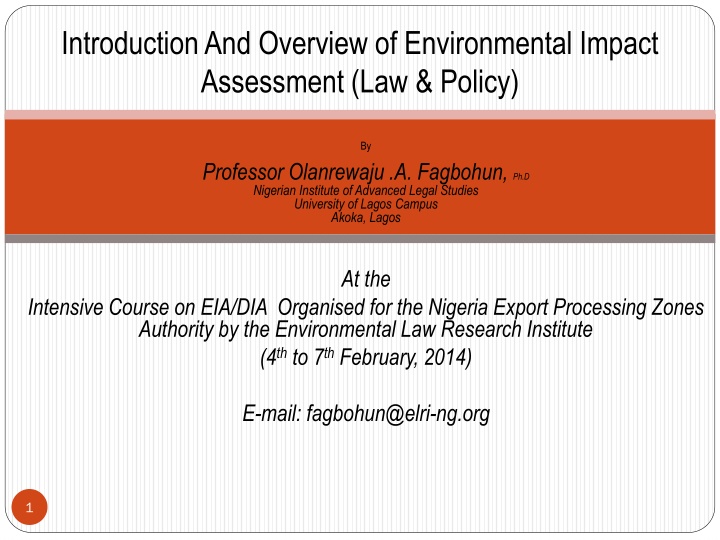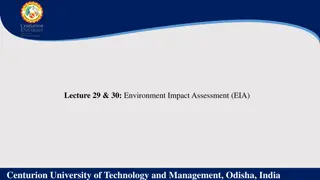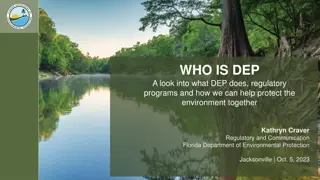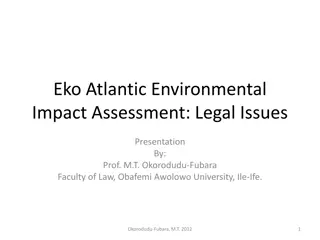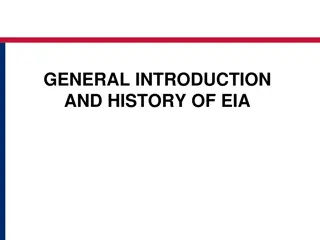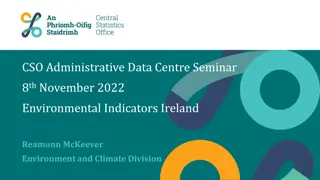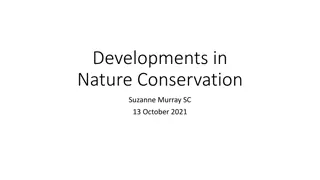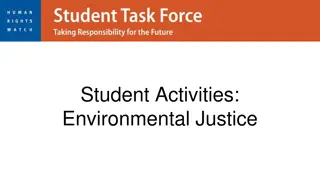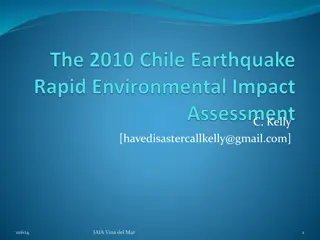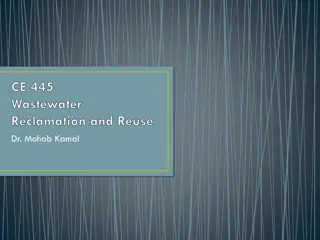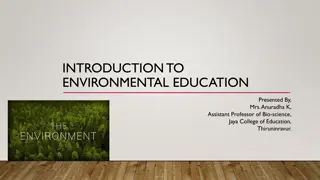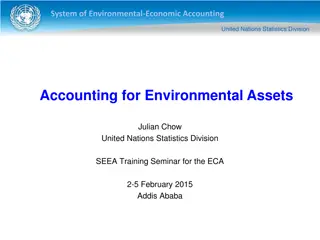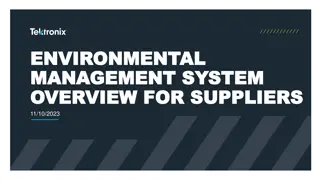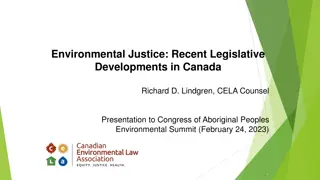Environmental Impact Assessment: Concepts, Principles, and Applications
This presentation by Professor Olanrewaju A. Fagbohun provides an in-depth overview of Environmental Impact Assessment (EIA) and Development Impact Assessment (DIA), highlighting their roles in environmental management and planning. The clarification of concepts such as EIA and DIA, along with guiding principles for EIA, offers a comprehensive understanding of how these assessments inform decision-making processes and promote sustainable development.
Download Presentation

Please find below an Image/Link to download the presentation.
The content on the website is provided AS IS for your information and personal use only. It may not be sold, licensed, or shared on other websites without obtaining consent from the author.If you encounter any issues during the download, it is possible that the publisher has removed the file from their server.
You are allowed to download the files provided on this website for personal or commercial use, subject to the condition that they are used lawfully. All files are the property of their respective owners.
The content on the website is provided AS IS for your information and personal use only. It may not be sold, licensed, or shared on other websites without obtaining consent from the author.
E N D
Presentation Transcript
Introduction And Overview of Environmental Impact Assessment (Law & Policy) By Professor Olanrewaju .A. Fagbohun, Ph.D Nigerian Institute of Advanced Legal Studies University of Lagos Campus Akoka, Lagos At the Intensive Course on EIA/DIA Organised for the Nigeria Export Processing Zones Authority by the Environmental Law Research Institute (4thto 7thFebruary, 2014) E-mail: fagbohun@elri-ng.org 1
Objectives Objectives Develop participants understanding of the concepts of Environmental Impact Assessment (EIA) and Development Impact Assessment (DIA); Develop participants appreciation of the roles that can be played by both EIA and DIA as strategic tools for environmental management and planning; Encourage participants to understand the use that can be made of EIA and DIA in the context of NEPZA s role as the Government Agency responsible for establishment of Free Zones in Nigeria, and the facilitation of investment into them. 2
Clarification Clarification of of Concepts Concepts EIA assesses and predicts the impact of a proposed project or action on human well-being, as well as the well-being of the ecosystems on which human survival depends. Identify potential environmental impact; Examine the significance of environmental implications; Assess whether impacts can be mitigated; Recommend preventive and corrective mitigating measures; Inform decision makers and concerned parties about the environmental implications; and Advise whether development should go ahead. 3
Clarification Clarification of of Concepts Concepts... ... DIA involves a process that is aimed at comprehensively evaluating the consequences of development on a community; DIA provides documentation of the anticipated economic, fiscal, environmental, social and transportation related impacts of a particular development on a community; The innovation behind both EIA and DIA processes is the systematic use of the best objective sources of information and the emphasis on the use of the best techniques to gather that information. 4
Guiding Guiding Principles Principles for for EIA EIA Transparency Participation Certainty Practicability EIA, as a systematic process of identifying future consequences of a current or proposed action Flexibility Credibility Cost Effectiveness Accountability 5
EIA EIA As As An An International International Concept Concept EIA requirements now forms part of many international agreements, and a number of global and regional organizations documents; EIA is numerously referred to in Agenda 21 and the World Summit on Sustainable Development s Plan of Implementation as a general obligation on States; Principle 17 of the Rio Declaration states that Environmental Impact Assessment as a national instrument shall be undertaken for proposed activities that are likely to have a significant adverse impact on the environment and are subject to a decision of a competent national authority. 6
Benefits Benefits And And Flaws Flaws of of EIA EIA Benefits Flaws Provides assessment; Estimates the cost/benefit trade-off of alternative actions; Facilitates public participation systematic methods of impact Time consuming Costly Little public participation in actual implementation. Provides Coordination/ integration/feedback. an effective negotiations/ mechanism environmental for: Unavailability of reliable data particularly in developing countries. Top-level decision-making Too focused on scientific analysis in many situations. Triggers an institutional building Poor/cumbersome presentation of EIA report (bulky volumes, scientific, difficult to understand). Achieve developmental and environmental concern a balance between impact of Compliance monitoring after EIA is seldom carried out. 7
Benefits Benefits of of DIA DIA Enhance sound land use management at local level; Promotes communication and conflict resolution among government officials and residents; Encourages responsive and informed decision-making; Addresses the range of potential impacts associated with a proposed development; Facilitate interagency cooperation and efficiency; Promotes consistency in the development process. 8
Guidelines Guidelines for for Analyzing Analyzing DIA DIA Evaluate both positive and negative impacts of the proposed development for each of the impact areas; Focus on significant (not nominal) effects of development; Consider both direct and cumulative impacts; Give high priority to community values and long-term goals of the community when assessing impacts; Involve the community in evaluating impacts, particularly socio-economic impacts. 9
EIA/DIA EIA/DIA In In the the Context Context of of the the Free Free Zone Zone Initiative Initiative Quare: NEPZA has received a request to consider the establishment of a Free Zone around AZPEN forest area. The promoters are in position to convince NEPZA that the proposed Free Zone can: attract foreign direct investment; facilitate technology transfer; enhance job creation; achieve utilization of local contents; engender skills acquisition; and aid foreign exchange earnings and revenue generation. (i) (ii) (iii) (iv) (v) (vi) Will the above provide sufficient justification for approval? 10
EIA/DIA EIA/DIA In In the the Context Context of of the the Free Free Zone Zone... ... NEPZA should be interested in the following: Whether the free zone development will affect environmentally sensitive areas (biodiversity/ ecology/land) within the context of social and economic setting, natural environment and the built environment; (i) Stakeholder consultations (including local community members) to take into account their concerns; (ii) Understand potential development impacts, including proper mitigation and enhancement values. (iii) 11
EIA IN NIGERIA EIA IN NIGERIA Regulated by Environmental Impact Assessment Act, 1992 (Decree No. 86 of 1992). EIA Procedural Guideline and Sectoral Guidelines Goals and Objectives; to establish, before a decision is taken by any person, authority, corporate body or unincorporated body, including the Government of the Federation, State or Local government intending to undertake or authorise the undertaking of any activity, those matters that may likely or to a significant extent affect the environment or have any environmental effect on those activities and which shall first be taken into account; a) b) promote implementation of appropriate policy; Encourage the development of procedures for information exchange, notification, and consultation... c) 12
Understanding Understanding The The Objectives Objectives Put together relevant baseline information; Provide requisite answers to the concerns and questions of stakeholders; Identify relevant socioeconomic and environmental aspects of a project; Suggest mitigation measures and re-design alternatives; Develop plans and procedures for effective proactive environmental management; Identify the legal, regulatory and policy framework, in the context of which, the EIA will be carried out for the proposed project. 13
Restriction Restriction Regarding Impact Impact Regarding Prior Prior Consideration Consideration of of Environmental Environmental Covers both ...public or private sector projects . Project is defined as the physical work that a proponent proposes to construct, operate, modify, decommission, abandon, or otherwise carry out, or a physical activity that a proponent proposes to undertake or otherwise carry out ; Extent, nature or location of a proposed project or activity must be likely to significantly affect the environment. 14
Minimum Minimum Content Content Of Of EIA EIA (S (S. . 4 4) ) A description of the proposed activities; a) A description of the potential affected environment, including specific information necessary to identify and assess the environmental effect of the proposed activities; b) A description of the practical activities, as appropriate; c) As assessment of the likely or potential environmental impacts of the proposed activity and the alternatives, including the direct or indirect cumulative, short-term and long-term effects; d) An identification and description of measures available to mitigate adverse environmental impacts of proposed activity and assessment of those measures; e) An indication of gaps in knowledge and uncertainty which may be encountered in computing the required information; f) An indication of whether the environment of any other State or local government area or areas outside Nigeria is likely to be affected by the proposed activity or its alternatives; g) A brief and non-technical summary of the information provided under paragraphs (a) to (g) of this section. h) 15
Excluded Excluded Projects Projects EIA is not required in the case of: a) Project with non or minimal environmental effect; b) Projects to be carried out during national emergency for which temporary measures have been taken by the Government; c) Projects to be carried out in response to be carried out in response to circumstances that, in the opinion of the Agency, the project is in the interest of public health or safety. 16
The Mandatory Study List... List covers: Drainage & Irrigation Airport Industry Forestry Agriculture Housing Mining Fisheries Mandatory List Infrastructure Land Reclamation Ports Railways Quarries Petroleum Power Generation & Transmission Resort & Recreational Development Transportation Waste Treatment & Disposal Water Supply 17
EIA EIA Procedural Procedural Guideline Guideline And And Sectoral Sectoral Guidelines Guidelines EIA Procedural Guideline Steps to follow in the EIA process (Annex I of the Procedural Guideline) Sectoral Guidelines Oil & Gas, including petroleum refining, petrochemical industry pipelines, on- shore, offshore exploration and drilling etc; Infrastructures including airports, construction, harbours, construction and expansion, railways, highways etc; Industries including all other manufacturing industries, besides those in the oil and gas sector; Agriculture all agricultural practices including land clearing, aforestation projects etc; Mining including solid minerals prospecting and exploration. 18
Categorisation Categorisation Of Of Study Study Activities Activities Category 1 full and mandatory EIA; Category 2 full EIA is not necessary unless the activity is within the Environmentally Sensitive Area; Category 3 activities having beneficial impacts on the environment; Extent of EIA are thus determined either through listing or an initial environmental evaluation (IEE). 19
The Categorisation Category 1 Agriculture Agro Allied Fisheries Forests Industry (manufacturing Food Beverages and Tobacco Processing) Infrastructure Ports Housing Airport Drainage and Irrigation Railway Resort & Recreational Development Power Generation Petroleum Mining Quarries Waste Treatment and Disposal Water Supply Land Reclamation Brewery Category 2 Agriculture and Rural Development Any restoration/afforestation project Small scale irrigation and drainage Small scale agriculture/manculture Saw milling/Wood logging Rubber processing Any fish processing Any other agro allied Industry and Infrastructure Mini hydro power development Any small scale industry development e.g. textile chemical industries Small scale power transmission Any renewable energy development Telecommunication facilities Rural water supply & sanitation Public facilities (Hospital, Schools, Housing) Road rehabilitation Any form of quarry or mining. Then Environmentally Sensitive Areas Coral reefs Mangrove swamps Small Island Tropical rainforests areas with erosion prone soils Mountain slopes area prone to desertification Natural conservation areas Wetlands of natural or international importance Areas with protected/endangered species Areas of unique scenery Areas of particular scientific interest Areas of historic/archaeological interest Areas of importance to threatened ethnic group Then Physical Interventions in the environment Category 3 Institutional development Health programmes Family planning programmes Nutritional programmes Educational programmes Environmental awareness 20 But if the project involves
The The EIA EIA Process Process In In Nigeria Nigeria Selection of Project EIA Team by the Project Proponent Submission of Proposal to FMoE Completion of EIA Notification Form Payment of N10,000 Initial environmental examination (IEE)/Preliminary assessment Consideration of all relevant information Project is assigned a category Screening Report is issued to Project Proponent. Submission of Terms of Reference (TOR) to FMoE Project Proponent submits its TOR covering environmental issues based on site scoping TOR must define all the issues EIA must address (i) Description of the proposed project; (ii) Objectives, Rationale and Benefits of the Project; (iii) Project Scope; (iv) Description of the Project Environment e.g. climate, air quality, soil, ecology, waste inventory, socio- economic/health assessment. Vetting and Approval of TOR (Site verification may be done to aid Scoping). 21
The The EIA EIA Process Process In In Nigeria Nigeria... ... Review and Hearing If not satisfied on an issue, FMoE may call for public/hearing further studies EIA Study and submission of draft EIA Report. Review of draft EIA Report In-House Review 21 working days public display (public participation/comments) Review Panel (may allow for further public participation) Mediation (effects that are immitigable FMoE Ministerial Council for referral). Revision of draft Report to address issues raised from review exercise/submission of final EIA Report within 6 months; Decision-making by FMoE s technical committee/Honourable Minister; EIA Approval (Environmental Impact Statement EIS is issued along with a certificate); 22 Impact mitigation monitoring (IMM).
PROPONENT SELECTION OF PROJECT TEAM FEASIBILITY STUDY OR PROJECT PROPOSAL FMoE EIA OFFICE INITIAL ENVIRONMENTAL EVALUATION MANDATORY PROJECTS EXCLUDED PROJECT OTHERS PRELIMINARY ASSESSMENT SCREENING NO EIA REQUIRED SCOPING DRAFT EIA REPORT PUBLIC HEARING MEDIATION REVIEW PANEL REVIEW REPORT PROPONENT FINAL EIA REPORT TECHNICAL COMMITTEE Decision Making Committee ENVIRONMENTAL IMPACT STATEMENT (EIS) AND CERTIFICATION ENVIRONMENTAL IMPACT MONITORING PROJECT IMPLEMENTATION COMMISSION 23 AUDIT
Imperatives Imperatives For For Proponents Proponents Adequate and effective Baseline studies Population characteristics (size and structure) Socioeconomic characteristics (Education/Health/Employment/Household Assets etc) Physical Environmental characteristics (Climatic factors/Ecology/Topography/Soil & Water Sampling etc) Effective Engagement with Target Communities Intimate key community stakeholders on impending exercise and purpose; Solicit their co-operation/assure no tax implications; Agree on sampling frame and sample size; Ensure geographic spread. 24
Challenges Challenges Too many regulators (conflict and overlap of responsibilities); Capacity building for regulators/administrators to avoid hijack of compliance monitoring and enforcement by proponents; Public participation is critical Need for involvement at early stage e.g. scoping (not just to comment on Report); Effective mechanism to manage the largely poor, illiterate and vulnerable public; NGOs and interested groups should develop an integrated, coordinated approach; . Affected states should be more involved (not just at Review Stage) 25
THANK YOU 26
